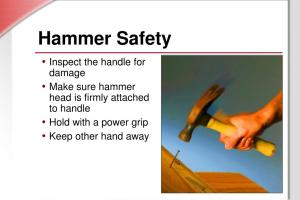Mastering Hammer Safety: The Ultimate Guide to Safe Hammer Use

-
Quick Links:
- Introduction
- Understanding Hammers
- Hammer Safety Tips
- Step-by-Step Guide to Using a Hammer
- Case Studies and Examples
- Expert Insights
- Common Mistakes in Hammer Use
- FAQs
Introduction
Hammers are one of the most essential tools in any DIY enthusiast's toolbox. Whether you're hanging a picture, building furniture, or tackling a construction project, understanding how to use a hammer safely is crucial. Poor hammering techniques can lead to accidents, injuries, and damage to materials. This guide will dive deep into the nuances of using a hammer safely, ensuring you can work efficiently without compromising your safety.
Understanding Hammers
Before we delve into safety practices, it's vital to understand the different types of hammers and their specific uses:
- Claw Hammer: Ideal for driving nails and removing them.
- Sledgehammer: Used for heavy-duty tasks like breaking concrete or driving stakes.
- Mallet: Often made of rubber or wood, used for delicate tasks like assembling furniture.
- Tack Hammer: Designed for driving tacks or small nails in upholstery work.
Hammer Safety Tips
Safety should always be your top priority when using a hammer. Here are some crucial safety tips:
- Wear Safety Gear: Always wear safety goggles to protect your eyes from flying debris.
- Check Your Hammer: Inspect the hammer for any damage before use.
- Use the Right Hammer: Ensure you're using the appropriate hammer for the task at hand.
- Maintain a Secure Grip: Hold the hammer firmly, with your hand positioned correctly on the handle.
- Be Mindful of Your Surroundings: Ensure that your workspace is clear of obstructions and that no one stands in the swing path.
Step-by-Step Guide to Using a Hammer
Using a hammer may seem straightforward, but proper technique is essential for safety and efficiency. Follow these steps:
- Choose the Right Hammer: Select a hammer suitable for your task.
- Position Your Material: Secure the material you're working on to prevent movement.
- Hold the Hammer Correctly: Grip the handle with your dominant hand, positioning your thumb on the opposite side.
- Position Your Non-Dominant Hand: Use your non-dominant hand to hold the nail or material in place.
- Strike the Nail: Swing the hammer with controlled force, keeping your elbow slightly bent for better control.
- Aim Carefully: Always aim for the center of the nail to avoid bending it.
- Inspect Your Work: After hammering, check the nail for proper placement.
Case Studies and Examples
Real-world examples illustrate the importance of hammer safety:
Case Study 1: The Importance of Grip
A carpenter suffered a finger injury while hammering because he did not maintain a proper grip on the hammer. The incident led to three weeks away from work, emphasizing the need for secure handling of tools.
Case Study 2: Choosing the Right Hammer
A DIY enthusiast attempted to use a sledgehammer for a delicate task, resulting in damage to the project. This case highlights the importance of selecting the appropriate tool for the job.
Expert Insights
We consulted with professional builders and carpenters to gather insights on hammer safety:
"Never underestimate the importance of a firm grip and a clear workspace. Most accidents occur when people rush the job," advises John Doe, a seasoned contractor.
Common Mistakes in Hammer Use
- Using a Hammer with a Loose Head: This can lead to the head flying off and causing injury.
- Overreaching: Stretching too far can lead to a loss of balance.
- Hammering with Too Much Force: This can lead to bent nails or damaged materials.
FAQs
- 1. What safety gear should I wear when using a hammer?
- Always wear safety goggles to protect your eyes from debris.
- 2. How do I know which hammer to use?
- Choose a hammer based on the task; for example, use a claw hammer for nails and a sledgehammer for heavy-duty work.
- 3. Can I use a hammer with a cracked handle?
- No, using a hammer with a cracked handle can be dangerous. Always inspect your tools before use.
- 4. What should I do if I miss a nail?
- Stop immediately and check your swing. Reposition the nail and try again with more control.
- 5. How can I avoid accidents while hammering?
- Maintain a clean workspace, use the correct hammer, and keep your hands away from the striking area.
- 6. Is it safe to use a hammer in wet conditions?
- Using a hammer in wet conditions can be risky due to slippery surfaces. Proceed with caution.
- 7. What are the most common injuries associated with hammer use?
- Common injuries include bruises, cuts, and finger injuries from missed strikes.
- 8. How can I improve my hammering technique?
- Practice with controlled swings and focus on aiming for the nail's center.
- 9. Should I wear gloves when hammering?
- While gloves can provide protection, they may also reduce grip. Assess the situation before deciding.
- 10. How often should I replace my hammer?
- Replace your hammer when it shows significant wear or damage, particularly the head or handle.
Random Reads
- How to learn type weaknesses in pokemon
- How to turn off light echo dot
- How to save videos on telegram
- How to scan barcode qr code iphone
- How to make a secret hideout in your closet
- Unlock national pokedex pokemon platinum
- How to wrap text in word
- Mastering youtube minimize videos
- Mastering header rows excel
- Mastering if else excel guide